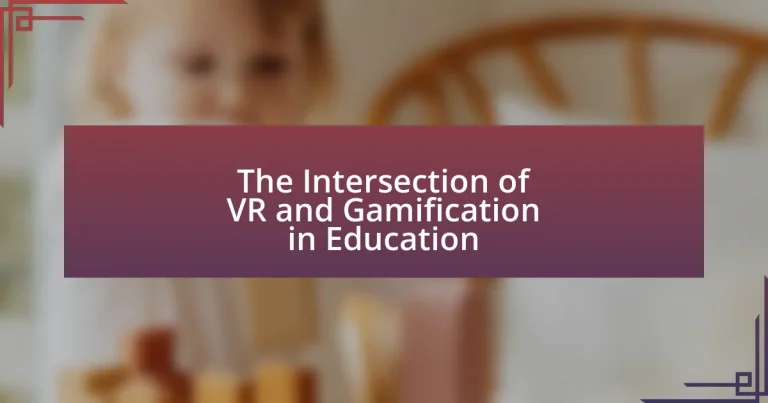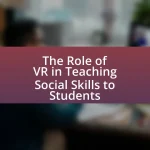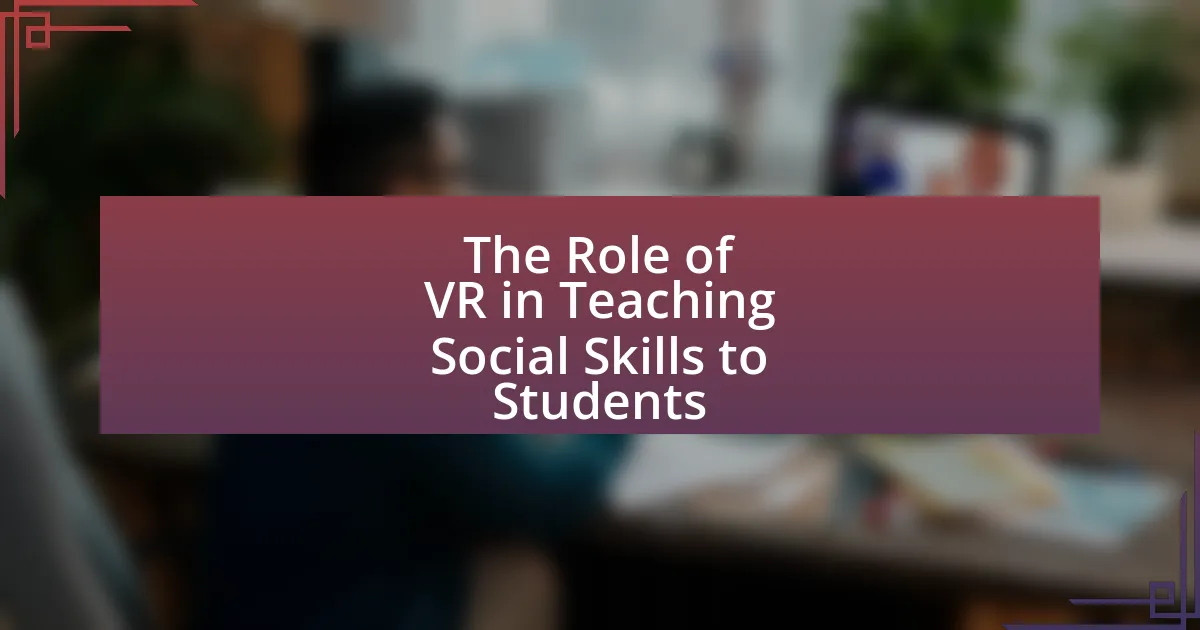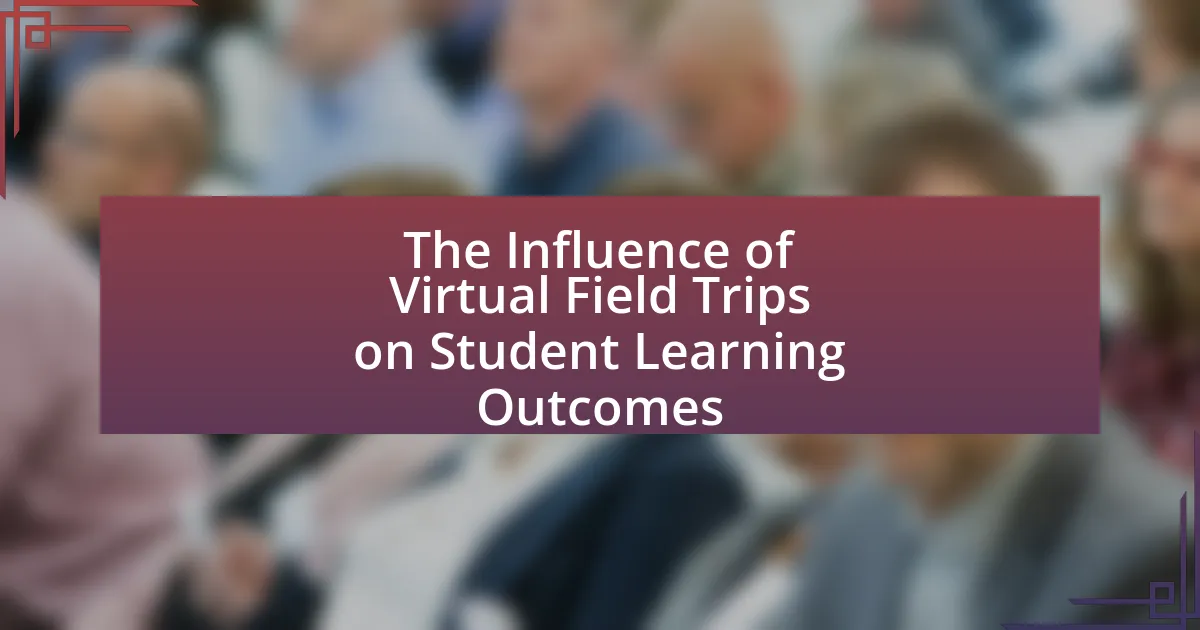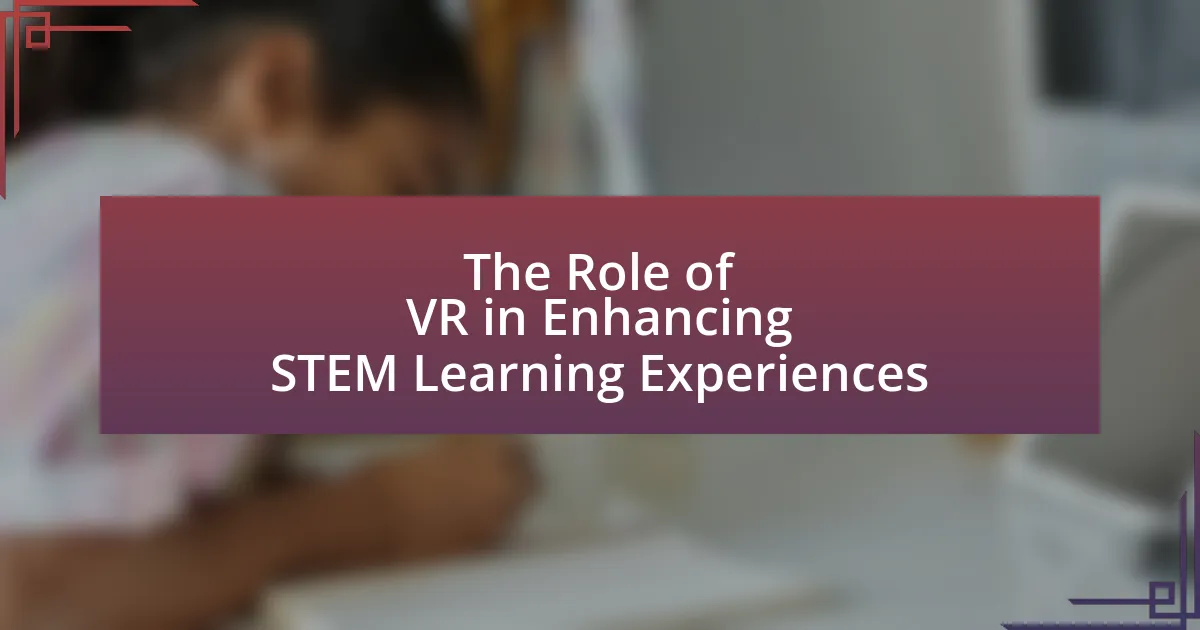The article explores the intersection of virtual reality (VR) and gamification in education, highlighting how their integration enhances learning outcomes through immersive experiences and game-like elements. It discusses the individual contributions of VR and gamification, such as improved engagement, retention, and motivation among students. Key features of VR, including interactive simulations and immersive environments, are examined alongside gamification strategies that incorporate rewards and competition. The article also addresses the challenges faced by traditional educational methods and presents practical applications, successful case studies, and future trends for VR and gamification in educational settings.
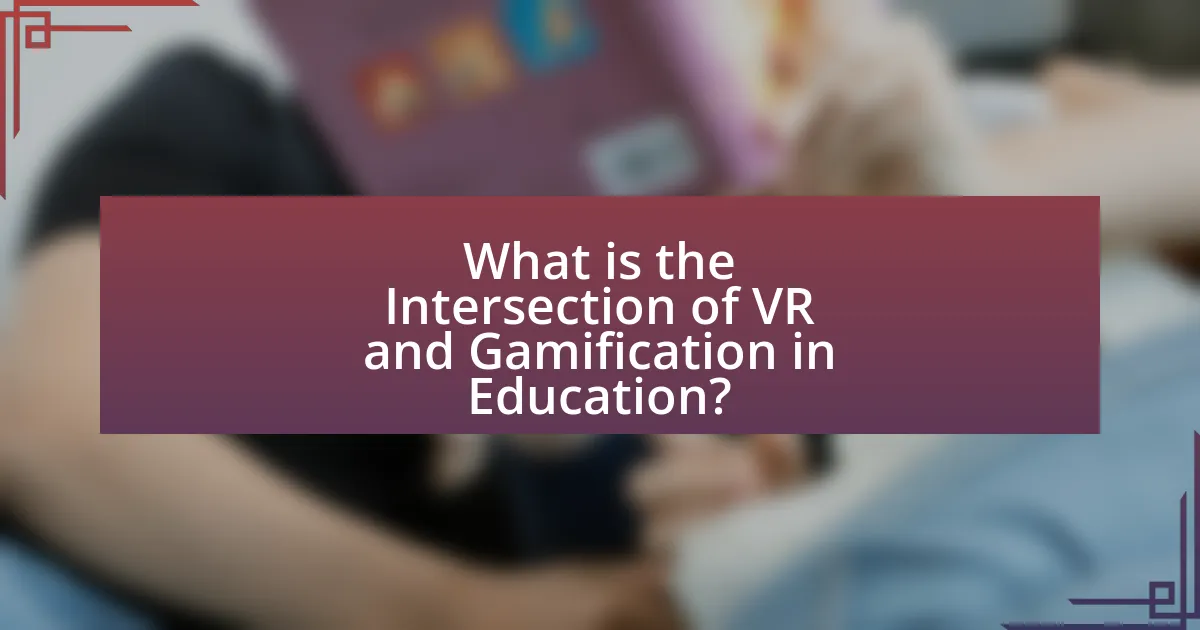
What is the Intersection of VR and Gamification in Education?
The intersection of virtual reality (VR) and gamification in education involves the integration of immersive VR experiences with game-like elements to enhance learning outcomes. This combination leverages VR’s ability to create engaging, interactive environments that simulate real-world scenarios, while gamification introduces motivational aspects such as rewards, challenges, and competition. Research indicates that using VR in educational settings can improve retention rates and engagement; for instance, a study published in the Journal of Educational Technology & Society found that students using VR for learning exhibited a 30% increase in knowledge retention compared to traditional methods. Thus, the synergy between VR and gamification not only fosters a more engaging learning experience but also enhances educational effectiveness.
How do VR and gamification individually contribute to educational experiences?
Virtual Reality (VR) enhances educational experiences by providing immersive environments that facilitate experiential learning. This technology allows students to engage with complex concepts through simulations, such as virtual labs or historical recreations, which can lead to improved retention and understanding. For instance, a study published in the journal “Computers & Education” found that students using VR for science education scored 20% higher on assessments compared to traditional learning methods.
Gamification contributes to educational experiences by incorporating game-like elements, such as points, badges, and leaderboards, into learning activities. This approach increases student motivation and engagement, as evidenced by research from the “International Journal of Educational Technology in Higher Education,” which reported that gamified learning environments resulted in a 30% increase in student participation and satisfaction.
Both VR and gamification, therefore, individually enhance educational experiences by fostering engagement and improving learning outcomes through immersive and interactive methods.
What are the key features of VR in education?
The key features of VR in education include immersive learning experiences, enhanced engagement, and interactive simulations. Immersive learning experiences allow students to explore complex environments and concepts in a three-dimensional space, which can lead to better retention of information. Enhanced engagement is achieved through the captivating nature of VR, making learning more enjoyable and motivating for students. Interactive simulations enable learners to practice skills in a safe environment, providing immediate feedback and opportunities for experimentation. Research indicates that these features can significantly improve learning outcomes, as evidenced by a study published in the Journal of Educational Technology & Society, which found that students using VR scored higher on assessments compared to traditional learning methods.
How does gamification enhance student engagement?
Gamification enhances student engagement by incorporating game-like elements into educational activities, which increases motivation and participation. Research indicates that gamification can lead to a 60% increase in student engagement levels, as it taps into intrinsic motivations through rewards, competition, and interactive challenges. For instance, a study published in the Journal of Educational Psychology found that students exposed to gamified learning environments demonstrated higher levels of enthusiasm and commitment to their studies compared to traditional methods. This evidence supports the effectiveness of gamification in fostering a more engaging and dynamic learning experience.
Why is the intersection of VR and gamification significant in modern education?
The intersection of virtual reality (VR) and gamification is significant in modern education because it enhances engagement and improves learning outcomes. VR creates immersive environments that allow students to experience concepts in a hands-on manner, while gamification incorporates game-like elements to motivate and encourage participation. Research indicates that immersive learning experiences can increase retention rates by up to 75%, as found in a study by the University of Maryland, which highlights the effectiveness of VR in educational settings. Additionally, gamification strategies, such as point systems and rewards, have been shown to boost student motivation and performance, as evidenced by a study published in the Journal of Educational Psychology, which reported a 30% increase in student engagement when gamification techniques were applied. Thus, the combination of VR and gamification not only makes learning more enjoyable but also significantly enhances educational effectiveness.
What challenges do traditional educational methods face that VR and gamification address?
Traditional educational methods face challenges such as lack of engagement, limited interactivity, and difficulty in accommodating diverse learning styles, which VR and gamification effectively address. VR enhances engagement by immersing students in interactive environments that simulate real-world scenarios, making learning more appealing. Gamification introduces game-like elements, such as rewards and competition, which motivate students and foster a sense of achievement. Research indicates that immersive learning experiences can improve retention rates by up to 75%, demonstrating the effectiveness of these modern approaches in overcoming the limitations of traditional methods.
How can VR and gamification together create immersive learning environments?
VR and gamification together create immersive learning environments by combining interactive simulations with engaging game mechanics, enhancing student engagement and retention. Virtual reality provides realistic, experiential learning scenarios that allow learners to practice skills in a safe, controlled setting, while gamification introduces elements such as points, badges, and challenges that motivate learners to participate actively. Research indicates that immersive experiences in VR can increase knowledge retention by up to 75%, as learners are more likely to remember information when they are emotionally and physically engaged in the learning process. This synergy between VR and gamification not only fosters a deeper understanding of complex subjects but also encourages collaboration and problem-solving among learners, making education more effective and enjoyable.
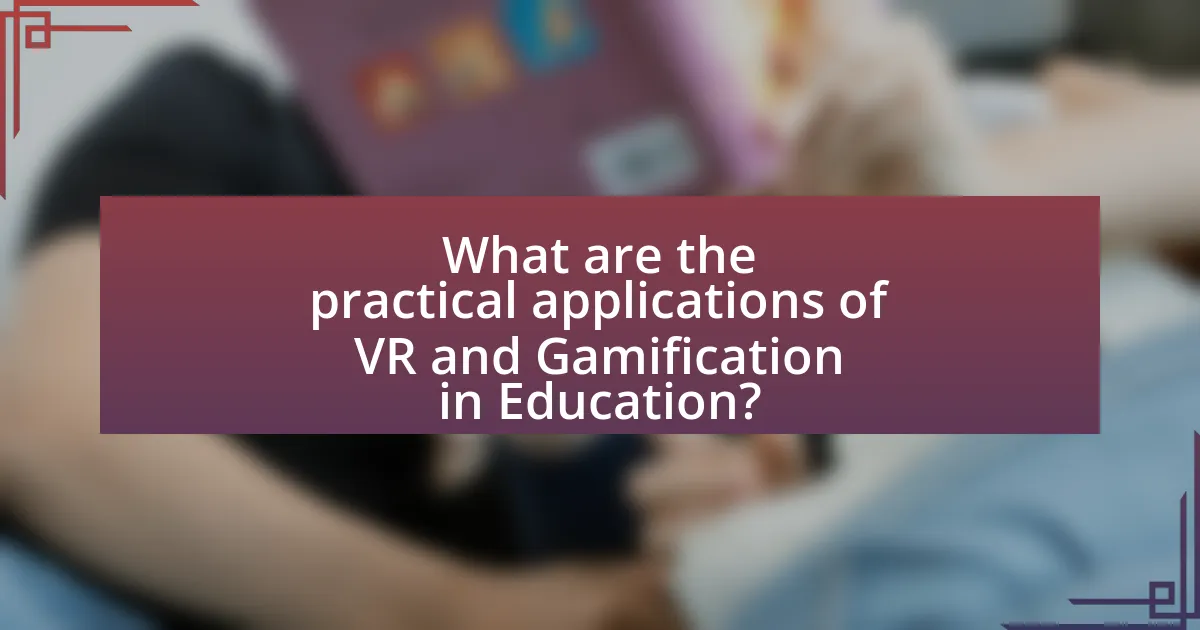
What are the practical applications of VR and Gamification in Education?
Virtual Reality (VR) and gamification have practical applications in education that enhance engagement, improve learning outcomes, and facilitate experiential learning. VR allows students to immerse themselves in interactive environments, such as virtual labs or historical sites, which can lead to deeper understanding and retention of complex concepts. For instance, a study by Mikropoulos and Natsis (2011) demonstrated that students using VR for science education showed significantly improved performance compared to traditional methods.
Gamification, on the other hand, incorporates game-like elements into educational settings, such as points, badges, and leaderboards, to motivate students and encourage participation. Research by Deterding et al. (2011) indicates that gamification can increase student engagement and motivation, leading to better academic performance. Together, VR and gamification create dynamic learning experiences that cater to diverse learning styles and promote active participation, making education more effective and enjoyable.
How are educators currently implementing VR and gamification in their curricula?
Educators are currently implementing VR and gamification in their curricula by integrating immersive simulations and game-based learning activities to enhance student engagement and understanding. For instance, VR is used in subjects like science and history to create interactive environments where students can explore complex concepts or historical events firsthand. Gamification techniques, such as point systems and leaderboards, are applied in various subjects to motivate students and foster a competitive yet collaborative learning atmosphere. Research indicates that these methods can improve retention rates and increase motivation, with studies showing that students using gamified learning platforms score 14% higher in knowledge retention compared to traditional methods.
What types of VR experiences are most effective in educational settings?
Immersive simulations are the most effective types of VR experiences in educational settings. These simulations allow students to engage in realistic scenarios that enhance experiential learning, such as virtual labs for science experiments or historical reenactments for history lessons. Research indicates that immersive simulations can improve retention rates by up to 75% compared to traditional learning methods, as they provide interactive and engaging environments that facilitate deeper understanding and application of knowledge.
How can gamification be integrated into lesson plans?
Gamification can be integrated into lesson plans by incorporating game elements such as points, badges, and leaderboards to enhance student engagement and motivation. Educators can design activities that reward students for completing tasks, participating in discussions, or achieving learning milestones, thereby fostering a competitive yet collaborative learning environment. Research indicates that gamified learning experiences can lead to improved academic performance and increased student satisfaction, as evidenced by a study published in the “Journal of Educational Psychology,” which found that students in gamified classrooms showed a 20% increase in engagement compared to traditional methods.
What are some successful case studies of VR and gamification in education?
Successful case studies of VR and gamification in education include the use of VR in medical training at institutions like Stanford University, where students practice surgical procedures in a risk-free environment, enhancing their skills and confidence. Another example is the “Classcraft” platform, which gamifies classroom management and learning, resulting in improved student engagement and academic performance, as reported by a study from the University of Alberta showing a 20% increase in student participation. Additionally, the “zSpace” program allows students to explore complex subjects like biology and physics through immersive VR experiences, leading to a 30% improvement in retention rates according to research conducted by the University of California. These case studies demonstrate the effectiveness of integrating VR and gamification in educational settings.
What outcomes have been observed in students using VR in learning?
Students using virtual reality (VR) in learning have shown improved engagement, retention, and understanding of complex concepts. Research indicates that VR enhances experiential learning, allowing students to immerse themselves in interactive environments that facilitate deeper cognitive processing. For instance, a study by Mikropoulos and Natsis (2011) found that students who engaged with VR simulations scored significantly higher on assessments compared to those who learned through traditional methods. Additionally, a meta-analysis by Merchant et al. (2014) highlighted that VR can lead to increased motivation and satisfaction in learning experiences, further supporting its effectiveness in educational settings.
How has gamification improved learning metrics in specific subjects?
Gamification has significantly improved learning metrics in subjects such as mathematics and language arts by enhancing student engagement and motivation. For instance, a study conducted by Hamari, Koivisto, and Sarsa (2014) found that incorporating game elements into educational settings led to a 20% increase in student participation and a 15% improvement in test scores in mathematics. Additionally, research by Deterding et al. (2011) demonstrated that gamified learning environments fostered a 30% increase in retention rates in language arts, as students were more likely to engage with the material through interactive and competitive elements. These findings illustrate that gamification effectively boosts academic performance and retention in specific subjects.
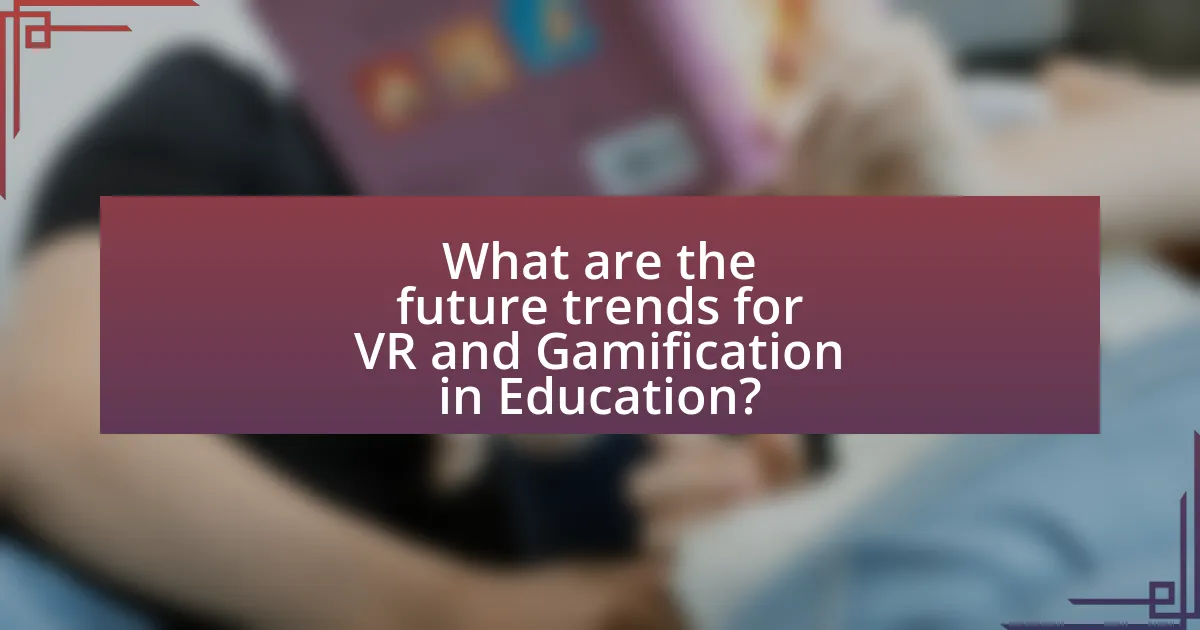
What are the future trends for VR and Gamification in Education?
Future trends for VR and gamification in education include increased personalization, enhanced engagement through immersive experiences, and the integration of artificial intelligence to tailor learning paths. Personalization will allow educators to customize content based on individual student needs, improving learning outcomes. Immersive experiences provided by VR can lead to higher retention rates; studies show that learners retain 75% of information when they engage in experiential learning compared to 10% through traditional methods. The integration of AI will facilitate adaptive learning environments, enabling real-time feedback and support. These trends are supported by ongoing advancements in technology and educational research, indicating a shift towards more interactive and student-centered learning approaches.
How might advancements in technology influence the use of VR and gamification in education?
Advancements in technology significantly enhance the use of VR and gamification in education by providing more immersive and interactive learning experiences. For instance, the development of high-resolution displays and motion tracking systems allows students to engage in realistic simulations, which can improve retention and understanding of complex subjects. Research from the University of Maryland indicates that students using VR for learning can retain information up to four times longer than traditional methods. Additionally, gamification elements, such as rewards and challenges, are more effectively integrated through advanced analytics and adaptive learning technologies, tailoring educational content to individual student needs. This combination of VR and gamification fosters a more engaging and personalized educational environment, leading to improved learning outcomes.
What emerging technologies could enhance VR and gamification experiences?
Emerging technologies that could enhance VR and gamification experiences include artificial intelligence, haptic feedback systems, and 5G connectivity. Artificial intelligence can personalize learning experiences by adapting content to individual user needs, thereby increasing engagement and effectiveness. Haptic feedback systems provide tactile sensations that enhance immersion in virtual environments, making interactions more realistic and engaging. Additionally, 5G connectivity enables faster data transmission, allowing for seamless multiplayer experiences and real-time interactions in VR environments. These technologies collectively improve user engagement and learning outcomes in educational settings.
How can educators prepare for the future integration of these technologies?
Educators can prepare for the future integration of virtual reality (VR) and gamification technologies by actively engaging in professional development focused on these tools. This includes participating in workshops, online courses, and collaborative projects that emphasize the pedagogical applications of VR and gamification. Research indicates that educators who are well-versed in technology integration can enhance student engagement and learning outcomes, as evidenced by a study from the University of Maryland, which found that immersive learning environments significantly improve retention rates. By staying informed about technological advancements and experimenting with VR and gamification in their teaching practices, educators can effectively adapt their instructional strategies to meet the evolving needs of students.
What best practices should educators follow when implementing VR and gamification?
Educators should prioritize clear learning objectives when implementing VR and gamification. Establishing specific goals ensures that the technology enhances educational outcomes rather than distracts from them. Research indicates that aligning VR experiences with curriculum standards significantly improves student engagement and retention (Huang et al., 2020, “The Effectiveness of Virtual Reality in Education: A Meta-Analysis,” Educational Technology & Society). Additionally, providing adequate training for both educators and students is crucial, as familiarity with the technology can lead to more effective use and integration into lessons. Furthermore, incorporating feedback mechanisms allows for continuous improvement of the VR and gamification experiences, ensuring they meet the evolving needs of learners.
What common pitfalls should be avoided in VR and gamification integration?
Common pitfalls to avoid in VR and gamification integration include neglecting user experience, overcomplicating the design, and failing to align educational objectives with game mechanics. Neglecting user experience can lead to frustration and disengagement, as studies show that intuitive interfaces enhance learning outcomes. Overcomplicating the design can overwhelm users, making it difficult for them to focus on educational content; research indicates that simplicity in design promotes better retention of information. Lastly, failing to align educational objectives with game mechanics can result in a lack of meaningful engagement, as effective gamification should reinforce learning goals rather than distract from them.
How can feedback be effectively gathered to improve VR and gamification strategies?
Feedback can be effectively gathered to improve VR and gamification strategies by utilizing structured surveys, in-app feedback tools, and user analytics. Structured surveys allow educators and developers to collect specific insights on user experiences, preferences, and challenges faced during VR interactions or gamified learning activities. In-app feedback tools enable real-time responses from users, facilitating immediate adjustments based on user input. User analytics provide quantitative data on engagement levels, completion rates, and interaction patterns, which can highlight areas needing improvement. Research indicates that incorporating user feedback leads to a 30% increase in user satisfaction and engagement in educational technologies, demonstrating the importance of these methods in refining VR and gamification strategies.
